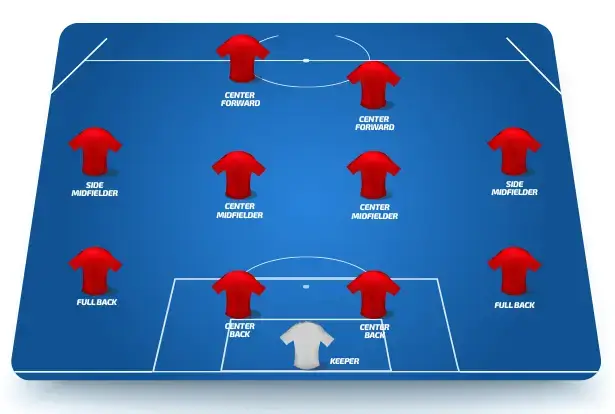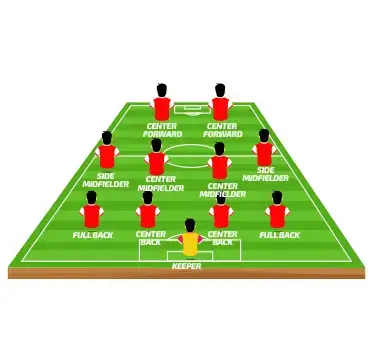CRFC BLOGS
LATEST BLOGS & NEWSLETTERS
A Comprehensive Guide to Mastering the Youth Soccer 4-4-2 Formation
The Youth Soccer 4-4-2 Formation is known for its balance, simplicity, and effectiveness on the field. Whether you’re coaching a fresh group of young players or looking to enhance your team’s strategic approach, understanding this formation is crucial. This article will guide you through every aspect of the 4-4-2 formation, from its basic structure and numbering to advanced tactics, potential weaknesses, and drills designed for youth players.
Youth Soccer 4-4-2 Formation
The Youth Soccer 4-4-2 Formation is a widely adopted strategy that positions four defenders, four midfielders, and two forwards on the field. Its popularity in youth soccer is mainly due to its straightforward structure, making it an excellent choice for teaching young players the fundamentals of soccer. The formation offers a clear division of roles and responsibilities, making it easier for players to grasp their positions and contribute to defense and attack.
Youth Soccer 4-4-2 Formation Positions and Their Roles
Each position in the Youth Soccer 4-4-2 Formation has specific responsibilities that contribute to the team’s overall strategy. Understanding these roles is essential for both players and coaches.
Fullbacks
The fullbacks are vital in providing defensive solidity and width in attack. They are responsible for covering the flanks, preventing opposition wingers from making dangerous runs, and supporting the midfield and forwards by overlapping and delivering crosses into the penalty area. Fullbacks must be quick, tactically aware, and have good stamina to cover large field areas.
Center-backs
The center backs form the core of the defense. The sweeper stays slightly behind the stopper to clear loose balls and cover for defensive mistakes. On the other hand, the stopper marks the opposition’s main forward and looks to intercept passes and block shots. Good communication between the center backs is essential to maintaining a strong defensive line.
Central Midfielders
Central midfielders are the team’s engine room, linking defense with attack. The defensive midfielder breaks up opposition play and protects the back four. Another is a more versatile midfielder, contributing to defensive duties and attacking moves. This player must have excellent vision, passing ability, and stamina to cover large field areas.
Wingers
The wingers provide the team width and stretch the opposition’s defense. They are responsible for delivering crosses into the box, taking on defenders, and tracking back to help their fullbacks when the team is defending. Wingers must be fast, skillful, and capable of making accurate crosses under pressure.
Forwards
The forwards are the team’s primary goal-scorers. The central striker stays close to the opposition’s goal and looks to finish off scoring opportunities. The second striker or attacking midfielder plays just behind the central striker, creating chances, linking up play, and also taking shots on goal when opportunities arise. The chemistry between the two forwards is vital for creating scoring opportunities.

Youth Soccer 4-4-2 Formation Tactics
The success of the Youth Soccer 4-4-2 Formation largely depends on how well the team executes its tactical plan. The formation’s simplicity allows for a variety of tactical approaches, depending on the team’s strengths and weaknesses.
Defensive Tactics
Defensively, the 4-4-2 is designed to be compact and organized. The two banks of four create a solid defensive block, making it difficult for the opposition to penetrate. The central midfielders play a crucial role in this setup, often dropping back to shield the defense and disrupt the opposition’s attacking play. The wingers are also expected to track back and support the fullbacks, mainly when the team is under pressure.
Attacking Tactics
On the attack, the 4-4-2 formation relies on the wingers to provide width and deliver crosses into the box for the forwards. The fullbacks often join the attack, overlapping with the wingers to create 2v1 situations on the flanks. The central midfielders support the attack by making late runs into the box, recycling possession, and keeping the pressure on the opposition. The forwards must work together to create space.
Transition Tactics
The 4-4-2 formation is characterized by quick transitions from defense to attack. When the team regains possession, the midfielders look to move the ball forward quickly, exploiting the spaces left by the opposition as they transition from attack to defense. The wingers and fullbacks push forward rapidly, providing options for a fast counterattack.
Weaknesses of the Youth Soccer 4-4-2 Formation
Despite its many strengths, the Youth Soccer 4-4-2 Formation has some inherent weaknesses that coaches and players must be aware of.
Midfield Vulnerability
One of the most significant weaknesses of the 4-4-2 formation is its potential vulnerability in midfield. Against teams that use formations with three central midfielders, such as the 4-3-3 or 4-2-3-1, the two central midfielders in the 4-4-2 can quickly become outnumbered. This can lead to the team losing control of the midfield, making it difficult to maintain possession and dictate the game’s tempo.
Defensive Exposures
Another weakness is the formation’s susceptibility to broad attacks. If the wingers do not track back effectively, the fullbacks can become isolated and overwhelmed by the opposition’s wide players. This can lead to dangerous crosses into the box and put additional pressure on the center-backs.
Predictability
The 4-4-2 formation is well-known and widely used, which can make it predictable and more accessible for opposing teams to plan against. Teams familiar with the 4-4-2 may exploit its weaknesses by overloading the midfield or focusing their attacks on the flanks.

Effective Youth Soccer Drills for 4-4-2 Formation
To get the most out of the Youth Soccer 4-4-2 Formation, it’s essential to incorporate drills that reinforce the formation’s principles and improve the players’ understanding of their roles.
Defensive Drills
Focus on maintaining shape and communication among defenders. Drills should emphasize the importance of staying compact and working as a unit to close down space and prevent the opposition from breaking through. Exercises like shadow defending, where players practice moving together as a block, can be very practical.
Passing and Movement Drills
These drills enhance the team’s ability to keep possession and move the ball quickly. Players should practice short, quick passes in small-sided games, with an emphasis on moving into space after passing the ball. This will help players develop the awareness and anticipation needed to execute the 4-4-2’s quick transitions.
Attacking Drills
Drills should focus on crossing and finishing to capitalize on the formation’s attacking strengths. Wingers should practice delivering accurate crosses into the box while forwards work on timing their runs and finishing. Combination play between the forwards and attacking midfielder can also be practiced to improve link-up play in the final third.
Counter Formations to the 4-4-2

While the Youth Soccer 4-4-2 Formation is versatile, several formations can be used to counter it effectively:
4-3-3 Formation
The youth soccer 4-3-3 formation overloads the midfield with three central players, making it difficult for the 4-4-2 to maintain control. The wingers in the 4-3-3 can also stretch the defense, exploiting the space behind the fullbacks.
4-2-3-1 Formation
The youth soccer 4-2-3-1 formation provides a strong defensive base with two holding midfielders while offering attacking width and central creativity. The 4-2-3-1 can outnumber the 4-4-2 in midfield and exploit the spaces between the lines.
3-5-2 Formation
The youth soccer 3-5-2 formation uses wing-backs to stretch the 4-4-2’s defense and adds an extra midfielder to dominate possession. This formation can be particularly effective if the wing-backs are quick and capable of delivering accurate crosses.
Understanding these counter-formations and how to adapt your team’s strategy against them is crucial for maintaining the effectiveness of the 4-4-2 in competitive matches.

Conclusion
The Youth Soccer 4-4-2 Formation offers a balanced approach to both defense and attack. Its simplicity makes it an excellent choice for youth teams, providing a clear structure that young players can easily understand and execute. By understanding and incorporating targeted drills and tactical adjustments, coaches can maximize the potential of the 4-4-2 and develop a well-rounded, competitive youth soccer team.
Join our Upcoming Seasons and Camps to learn and practice youth soccer formations.
FAQs
What is the best way to teach the 4-4-2 formation to youth players?
Start by explaining the basic positions and roles using simple language and visuals. Use small-sided games and specific drills to reinforce positioning and teamwork.
What are the key strengths of the 4-4-2 formation in youth soccer?
The 4-4-2 provides a balanced approach, offering solid defensive coverage while still enabling effective counter-attacks. It is ideal for youth teams that want to grasp both defense and attack.
How can we address the midfield weakness in a 4-4-2 formation?
Encourage wingers to tuck in and help the central midfielders, or consider switching to a diamond variation to strengthen the midfield control.
What drills are effective for practicing the 4-4-2 formation?
Focus on drills that emphasize teamwork, such as passing triangles, defensive shape exercises, and crossing and finishing routines that mimic game scenarios.
How does the 4-4-2 diamond differ from the standard 4-4-2?
The 4-4-2 diamond formation emphasizes central control with a narrower midfield, allowing better ball retention but potentially sacrificing width.

Did you find this useful?


